Three Decades of Memories -The History of the National Show Glass Commemoratives
Reprinted from "Crown Jewels of the Wire", May 1999, page 43
The Commemorative Originators, Frank and Margaret Miller
(Part III)
The "Turn" and Glass Production
Glass production time is purchased in "turns." A turn is a
four-hour period of time. The 1970 and 1971 runs were, of course, a very small
operation at Overmyer-Perram in Tulsa. From 1972 through 1983 a very controlled
production run took place. Frank Miller would arrive with the mould from Tulsa,
the commemorative would be run for four hours, and Frank would remove ALL
insulators run during the production. Of course, units that were cracked were
destroyed in a barrel at the end of the cooling lehr. Frank did take with him
those that might have small imperfections -- a weak embossing, air bubbles, a
little lopsided or those with small "potstones" (pieces of firebrick
that would break off into the furnace of molten glass), the last of which seemed
most prevalent in the amber run in 1977. "The mold never left my sight the
entire time we were in the glasshouse," said Miller.
The items from each production run that hold the most fascination for
collectors are the "warming pours". During each "turn" of
production, the pressmen take a five minute break every hour on the hour. When
they return to production, the mould is filled with molten glass three or four
times and not plunged, just to get the mould up to the correct temperature and
readied for the next hour's run. These large, solid glass commemoratives do not
cool well and tend to sag. Many will not survive the annealing process in the
lehr. Each year, the pours have numbered from a couple to a dozen that have
cooled in one piece.
When ordering a glass "turn", the Millers and the McDougalds were
at the mercy of the ability of the men operating the press. Whatever was
produced in the four-hour run was what was netted for the year's run. Most of
the early years averaged around 300 good insulators. Beginning in 1984, the
production rules changed at Mosser so that the insulators were ordered "by
the piece." This way, the number of units produced was guaranteed. As the
popularity of the commemorative has increased, the number of units ordered has
also increased to satisfy the number felt necessary to satisfy the collectors.
Frank Miller was often heard to say that "the mold never left his
sight" during production. He was unaware of some of the oddities that
occurred during his years of production. These happened during the runs at the
Overmyer-Perram and St. Clair glasshouses. However, there is a possible
explanation.
In a glasshouse; there are usually two rooms. The first one is where the
molten glass is gathered from the oven and placed into the mould, pressed, fired
and taken to the cooling lehr. A long trip down the moving belt of the lehr
(approximately 75 to 100 feet in length) finds the insulators emerging in a
second room where they are given a final inspection and packed into boxes. It is
entirely conceivable that the pressmen may have taken an opportunity at the end
of a run to make some oddities, while the mold owner was packing at the other
end of the lehr. Embossing a penny in the dome, spraying with carnival, using a
glass color from another oven to press several units, throwing cullet of a wide
range of colors into the mould or placing units into an acid bath to make some
bizarre "end of the day" samples is entirely possible. They can then
be placed on the back end of the lehr or even on a second, slower lehr belt and
never detected by the owner. So, it is entirely possible that shenanigans took
place undetected by the Millers. They could have left the building and returned
for the mould once it had cooled, and never been aware of the strange items
using their mould that have shown up in flea markets or found in the possession
of glass workers over the years.
The McDougalds have always stored the mould at Mosser Glass and taken only
the embossing rings out for erasure and re-engraving. And, since 1988, they have
not been present at Mosser for any of the productions runs. Mosser has been very
diligent about production, but there is always the possibility that strange
anomalies may surface at some point in the future. The only whimsical pieces
that have ever been created that are known to the McDougalds occurred in 1979
when one of the pressmen made about a half dozen ashtrays by putting cigarette
rests on the base of underpoured pieces.
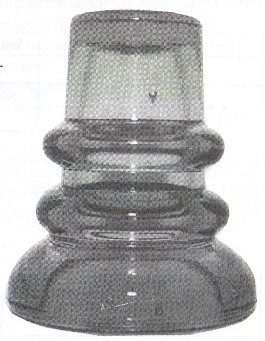
1992 -- The Year of the Bonus
There were two years when Mosser Glass had some problems during the
production. The first occurred in 1992. The show hosts had requested a glass
color called "neodymium". It is a glass that is pink in natural
lighting, but turns a beautiful blue lavender color under fluorescent lighting.
Describing the color over the phone to the glasshouse brought an affirmation
that they knew the glass color and that they would be able make the color for
us. What could go wrong? We were choosing a color that was in their recipe
book.
1989 Commemorative Embossing:
20TH NIA CONVENTION
ALLENTOWN, PA JULY 14-16 1989
Dome Logo: Large keystone; Hawley signal; 20th show logo

The cost of the 1990 commemorative was $16.00 each.
1990 Commemorative Embossing:
21st NIA CONVENTION
PORTLAND, OREGON JULY 6-8, 1990
Dome Logo: Oregon state outline & five point star for Portland
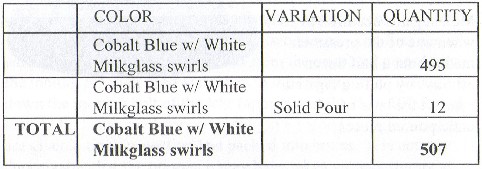
The cost of the 1991 commemorative was $17.00 each.
1991 Commemorative Embossing:
22ND NIA CONVENTION
CEDAR RAPIDS, IOWA JULY 26-28, 1991
Dome Logo: Missouri Valley Insulator Club logo
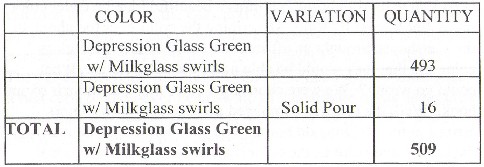
Well, the run was completed and nearly 500 insulators arrived at the
McDougald home. The first box was opened to find the exact same color as the
color run for the Rochester national show in 1983. Mosser checked their records
of glass colors run, and sure enough, they had run the same color as 1983. What
to do? Mosser suggested shipping back the lilac insulators to let them frost
their surface with an acid solution. So, one insulator was sent to them for
frosting to see if that would be acceptable. They returned one frosted
insulator, and it was decided that frosting the entire run was not acceptable.
"What production color are you doing right now?"
"Cobalt", was the answer. Cobalt had been run before. What other
suggestions?
"How about cobalt and then spraying them with carnival?" That
sounded like a better option. So, another order was placed for the 1992
commemorative...this time in cobalt carnival. Two weeks later another shipment
of insulators arrived.
"What do you want me to do with the first order in lilac?"
"They are yours, FREE," said Mosser. "It was our
mistake."
So, with each order for the 1992 commemorative received, a matching
"bonus" lilac was sent at NO CHARGE. The cost of the commemoratives
was $18.00 for the pair.
1992 Commemorative Embossing:
23RD NIA CONVENTION
ORLANDO, FLORIDA JUNE 19-21, 1992
Dome Logo: Central Florida Insulator Club logo
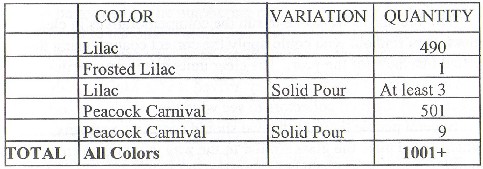
1993 Commemorative Embossing:
24TH NIA CONVENTION
DENVER, COLORADO JULY 2-4, 1993
Dome Logo: Triple Ridge Insulator Club logo
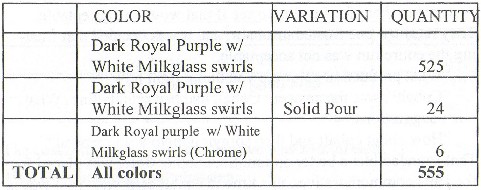
1994 - The Silver Anniversary
How does one make a silver glass commemorative? The McDougalds assumed that a
clear insulator could be sprayed with a color (similar to the way in which the
carnival coating is applied) at the time of pressing, and be annealed to the
insulator surface during cooling. Unfortunately, no such coating exists, and
Mosser Glass suggested that Custom Decco of Toledo, Ohio, be contacted to apply
a silver coating to the insulators after production. Four of the 1993 run were
sent to Toledo for a test of their coating procedures. The coating resembled the
color of chrome and not silver. Since the 1993 insulators were dark purple, it
was thought the lackluster color might be attributed to the color of the test
samples from that year.
The first move would be to run the commemoratives in clear glass, then find
out who could apply the correct coating using the actual insulator for the year.
The clear units were very sterile-looking pieces of glass when they arrived, so
the McDougalds began checking with collectors to see what they might suggest. .
Several people thought that we should contact a company which could plate the
glass similar to the way in which mirrors are manufactured. P.A. Clausing
Company in Skokie, Illinois, a firm that designed optics, parabolic mirrors and
telescope objectives was located. The project was explained. Two clear
commemoratives were sent, and again a chrome-looking coating was applied. Then
Clausing coated two small jars with a mirror application. Bingo! That was the
look needed.
The mirror-like coating of beryl aluminum was applied to the surface of each
insulator within a vacuum chamber. Only eight insulators could be treated at a
time due to the size of the chamber. Fortunately the process was started early
in the year so that the applications could be completed in time for the July
show in Houston. The cost of the 1994 commemoratives was $22.00 each.
1994 Commemorative Embossing:
25TH NIA CONVENTION
HOUSTON, TEXAS JULY 1-3, 1994
Dome Logo: Five point Lone Star with 25 in the middle
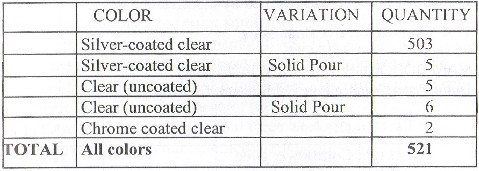
One may also wonder why the 30th NIA national show is coming up, and yet the
National Insulator Association is only 26 years old, having been formed at the
national show in Hutchinson, Kansas in 1973. (It probably never occurred to
Frank Miller, when he began the commemoratives in 1970, that a national
association would be formed.) The numbering of the commemoratives began with the
1970 national "meet", and continued to designate the national show
each year, even for those shows that took place before the NIA was formed. So,
the 1974 commemorative is embossed "NIA FIFTH NAT'L SHOW", and
subsequent years "6TH NIA CONVENTION", etc. In other words, the
commemorative "adopted" the NIA shows (or maybe the NIA
"adopted" the commemorative) after 1973. This may clear up the
confusion for the purists in the hobby who have observed that the NIA saw its
25th year in 1998.
As part of the 1995 national convention festivities, two members of the
National Insulator Association, Jack Riesselman and Jerry Turner were honored
for their attendance record at national shows. Nothing special had ever been
done since the "lucky seven" were honored at the 10th national show in
Denver in 1979. Both Jack and Jerry missed one of the shows during the first 10
years, so they were not recognized as part of the "Lucky Seven".
However, 1995 would be the 25th national show they had participated in. The show
hosts requested that two of the light cornflower blue commemoratives be plated
with silver so that they might be presented to Jack and Jerry at the awards
banquet.
P. A. Clausing was again contacted, but they would not do just two
insulators. They needed a minimum order of six commemoratives. The four extra
silver-coated pieces were given to each of the show hosts and one was retained
by the McDougalds.
1995 Commemorative Embossing:
26TH NIA CONVENTION
MARLBOROUGH, MA JULY 14-16 1995
Dome Logo: Yankee Pole Cat Insulator Club logo

In 1996 the show hosts suggested a new idea for a glass color -- a clear
glass with a cobalt blotch, similar to the CD 155 Kerr insulators that were
produced in the early 1970's when cobalt cullet was added to the mould filled
with clear glass. A borrowed Kerr insulator was sent to Mosser. "No
problem, we can make that," was Mosser's reply. Why does that line sound so
familiar?
The two transparent colors stayed separated a little better in this run than
they did in the green and amber transparent colors of 1986. However, the cobalt
in clear glass was not nearly as dramatic as it had been in the Kerr insulators.
Both tanks of molten glass were tested prior to each "turn", resulting
in solid pours of each.
1996 Commemorative Embossing:
27TH NIA CONVENTION
LONG BEACH, CALIF JULY 19-21, 1996
Dome Logo: Sea horse show logo

So, one more time we would send a sample of what we wanted in the way of a
color to Mosser Glass. The 1997 show hosts requested that we try a red color
similar to that found in the 1972 private issue McLaughlin commemoratives. It is
a gorgeous opaque red and would be a great color if they could make it. We
borrowed the insulator and sent it to Mosser. "No problem, we can make
that. We used to make a color just like that."
The order was placed and about three weeks later, a call came from Mosser
Glass. "Your commemoratives are ready."
"How do they look? Did you get the red color to match?"
"Well, not exactly..."
"Did you run the entire order?"
"Yes, I'll send one up for you to look at, and I am going to reheat one
to see if the color is changed to a better red."
Several days later, a package arrives with two pieces; the RED and the RED
REHEATED. Imagine a bowl of Campbell's tomato soup -- a yucky salmon milkglass.
That was the color of the "red," and the heated red had lost all of
its sheen. They both were U-U-U-U-U-GL Y! Mosser destroyed the entire run. Black
glass amethyst was in the tanks which Mosser was carnivalizing for a customer.
Four carnival samples arrived by overnight mail, but it was determined that they
could not be distinguished from the 1992 peacock carnival. The 1997 run was
completed in black glass amethyst without the carnival coating. A major
disappointment when you thought you were going to have a red commemorative.
1997 Commemorative Embossing:
28TH NIA CONVENTION
CHICAGO, ILLINOIS JULY 25-27, 1997
Dome Logo: Illinois state outline logo
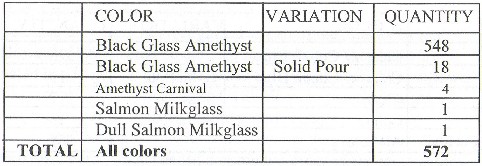
Over the years, commemorative collectors have suggested that actual
insulators be used to make one of the year's colors. The glasshouse could be
provided with enough damaged insulators to make enough cullet to produce a
"real insulator" commemorative if they were willing to do so. However,
since glassmaking is so very critical, Mosser Glass needs to be in control of
the elements used to make the batch of molten glass. And, insulators have far
too many impurities which could cause a lot of problems during production and
damage the tanks in which the glass is melted.
The color aqua had always been synonymous with insulators and was a color
that had not been run previously. Another customer who produces a short run
product at Mosser annually was using aqua glass in the spring of 1998, so it was
decided to have the commemoratives for Williamsburg run at the same time using
the same batch of glass.
1998 Commemorative Embossing:
29TH NIA CONVENTION
WILLIAMSBURG, VA JULY 31-AUG 2, 1998
Dome Logo: Chesapeake Bay Insulator Club logo with B&O insulator

End of Three Decades -- Ruby Red
Ten years ago, Mosser Glass Company began constructing a tank that would
produce ruby red glass. And, it wasn't until a call was placed to their plant in
early January that the question was asked, "What colors are you producing
this spring?"
"We are in ruby red. Would you like that color? Is the mould ready with
the new embossing?"
The mould was at the engravers and Mosser was in ruby red. A quick call to
Cleveland, Ohio, where the engraving is done indicated that the mould was on its
way to the McDougalds in Chicago. When it arrived, it was sent by overnight
delivery to Cambridge, Ohio. The run in ruby red WOULD take place. The use of
gold chloride added considerably to the cost of production. The 1999
commemorative cost $25.00 each.
Ruby red -- a fitting celebration for our 30th year!
1999 Commemorative Embossing:
30TH NIA CONVENTION
SCOTTSDALE, AZ JUNE 25-27, 1999
Dome Logo: Grand Canyon State Insulator Club logo

This history was prepared from the commemorative production records and notes
by John and Carol McDougald. Statistics included in this presentation on
oddities during production were gathered by Kevin Lawless and John Hunsaker for
their noncompetitive exhibit of commemoratives and private issue insulators for
the 1998 national in Williamsburg, Virginia. Thank you, gentlemen. And, special
thanks to Clarice Gordon for assistance in the production of the text.
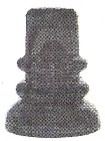
Copyright © 1999 by Crown Jewels of the Wire
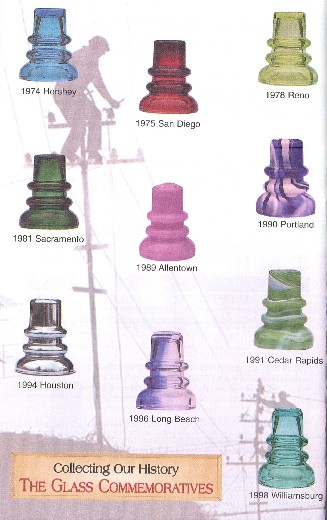
| 